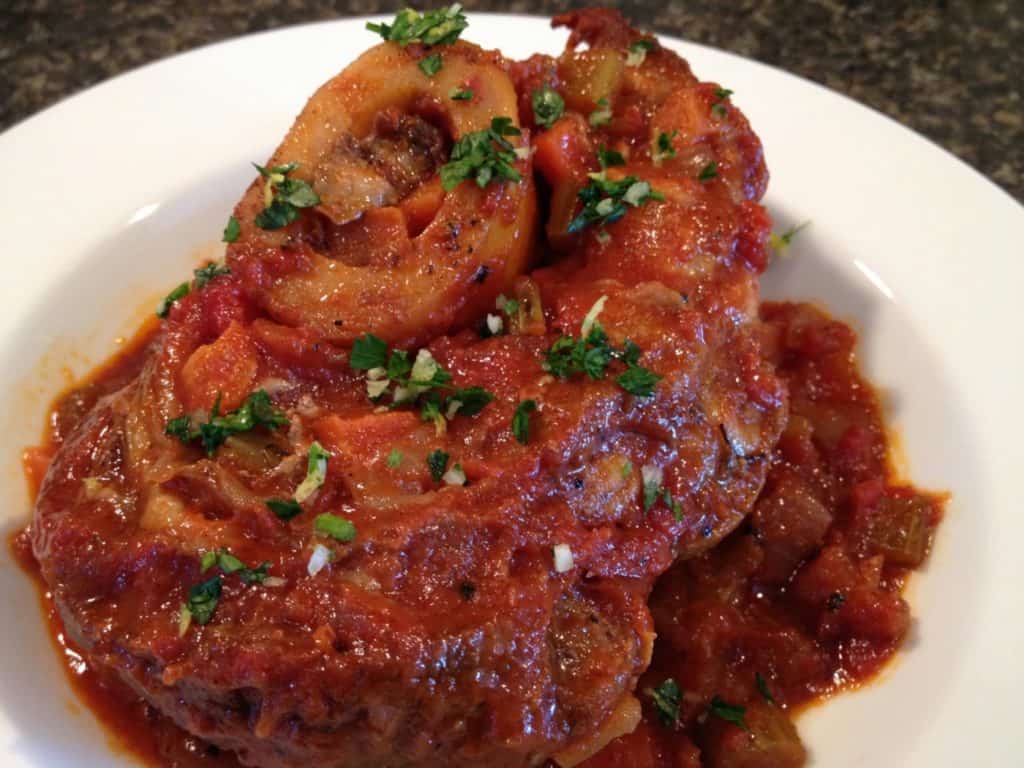This classic Milanese braise literally translates as “bone with a hole,” in reference to the succulent exposed marrow from the cross-cut shank bone. Although the dish is traditionally made with veal shanks, I’ve found that beef is not only much more economical but seems to contain more flavor than its younger counterpart, so it’s a no-brainer for me to swap the two in my household.
There’s clearly something special about bone marrow. It was the primary ingredient in pemmican, a transportable, highly caloric and nutrient-rich food used by early explorers in Northern Canada, the Arctic, and Antarctica. Deeply regarded as a nourishing delicacy in many parts of the world, the stuff is massively underappreciated in Western society; more often than not, it’s seen as somewhat of a byproduct, so it’s routinely discarded. I suppose this is probably a good thing for those of us that relish the silken texture and luscious taste, as marrow bones are fairly accessible and inexpensive. I know my dog agrees. When I give him a bone with his meat, he always sucks the marrow first.
Bone marrow, a magnificent nutrient-dense brain food, is comprised mostly of fat that is, surprisingly, predominantly monounsaturated, along with elevated levels of conjugated linoleic acid and omega-3 fatty acids. These super fats are all responsible for tissue repair, energy production, cell structure, and immune system support. Bone marrow is also a good source of vitamin A and major minerals like calcium, iron, and zinc, and the nutrients contained in it are extremely accessible for our bodies to convert into energy, strength, and healing.
For more about using bone marrow and other nutrient-dense animal parts, read Organ Meats Are Offal Good by Gerald Roliz, CNC. Also visit the SRP Historical Archives and read the 1943 article, “Unusual Meats: How to Prepare and Serve Them.” It provides an exhaustive list of details about organ meats, as well as over 30 recipes, including Bone Marrow on Toast, Liver Scalloped with Potatoes, and Philadelphia Pepper Pot.
Thankfully, a dish like osso buco gives folks the opportunity to receive some of the benefits from the bone, even if they are squeamish about the idea of eating the marrow straight-up. During the long, slow braise, the bones release a myriad of vitamins and minerals, along with sensational substances such as gelatin and collagen, and all this goes into the rich gravy which accompanies the shanks. And the dish only gets better if made a day or two before serving, then reheated. If you want to stick with tradition, serve this with Risotto Milanese, a creamy rice flavored with saffron and Parmesan.
Ingredients
Serves 4
Beef Shank Osso Buco
4–8 large beef shanks, depending on size, cut about 2 ½ inches thick
Salt and pepper
Flour, for dredging shanks (optional)
4–6 tablespoons butter or beef fat
1 large onion, diced
1 carrot, diced
2 stalks celery, diced
2 cloves garlic, minced
6 parsley stems
4 sprigs fresh thyme
2 fresh or dried bay leaves
1 1/2 cups white wine
2-3 cups beef or chicken stock (link to chicken stock post – I know there was one, maybe by Paula?)
1 1/2 cups roughly chopped canned or fresh tomatoes
Gremolata
1/2 cup finely chopped parsley
2 tablespoons finely grated lemon or orange zest
2 cloves garlic, minced
Method
1. Preheat the oven to 325 F. Securely tie shanks around circumference with kitchen twine. Season with salt and pepper. If using flour, spread in a shallow bowl, and dredge shanks in it, patting off excess. Make a bouquet with parsley stems, thyme, and bay leaves. Secure tightly with twine.
2. Heat about half the butter or fat in a large Dutch oven or other heavy pot. Sear shanks, without crowding them, over medium-high heat until deeply browned on each side. Transfer to a plate or large bowl, and set aside.
3. If necessary, add a little more fat to pan. Saute onions, carrot, and celery until lightly golden, about 5 minutes. Add garlic and herb bunch, and sauté 1 minute. Add wine and bring to a boil. Reduce heat and simmer until wine is reduced by about half. Add tomatoes to pot and stir to combine.
4. Return shanks to pot, along with any accumulated juices from plate. Pour in enough stock to almost cover the shanks. Cover pot and bring to a boil on stovetop. Transfer to the preheated oven and braise for about 2–2 ½ hours, or until meat is very tender. Check shanks periodically, adding additional stock to pot if the sauce is drying out too much.
5. Prepare gremolata by combining finely chopped parsley, lemon zest, and garlic. To serve, cut twine from shanks and serve 1–2 shanks per person, along with some of the braising gravy. Sprinkle with gremolata before serving.
For more on cooking with bone marrow and other less popular animal parts, check out Odd Bits: How to Cook the Rest of the Animal.
For more on how to incorporate good fats into your diet and how to identify good fats, check out the following titles SRP has to offer:
Eat Fat, Lose Fat
Know Your Fats
AUTHOR’S NOTE
To choose your organically grown and fresh ingredients wisely, use the following criteria:
·chemical- and hormone-free meat
·wild-caught fish
·pastured-raised, organic eggs
·whole, unrefined grains
·virgin, unrefined, first-press organic oils
·whole-food, unrefined sweeteners
·pure, clean, spring water
·sea salt
·raw and/or cultured milk and cream products


